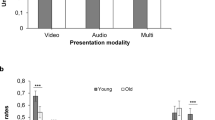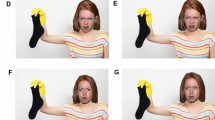Abstract
Background and aims: Experience of emotions changes with age: older adults report fewer intense negative emotional experiences, and are less accurate in labelling facial expressions of some negative emotions. However, there is little empirical evidence as to the effect of age on perception of intensity of emotions. This study aims to investigate whether younger and older adults differ in their ratings of the intensity of others’ emotions as presented in photographs of faces and descriptions in text. Methods: Age effects on intensity ratings of emotions (happiness, fear, anger, sadness) from photographs of facial expressions and verbal descriptions of emotions in text were investigated in 91 healthy adult participants. Relationships of these intensity ratings with measures of cognitive ability and current mood were also examined. Results: Older participants perceived lower levels of emotional intensity in sad and happy faces. Compared with the older group, younger adults perceived neutral faces as showing high anger levels. Younger adults also rated protagonists in stories as experiencing high levels of fear. Most of the age differences could be statistically explained in terms of anxiety, depression, and intelligence test scores. Conclusions: Older adults rate some aspects of emotions portrayed in facial expressions and written text as less intense. This may partly reflect better emotional adjustment with age, as reflected in lower levels of anxiety and depression.
Similar content being viewed by others
References
DePaulo BM. Nonverbal behavior and self-presentation. Psychol Bull 1992; 111: 203–43.
Carton JS, Kessler EA, Pape CL. Nonverbal decoding skills and relationship well-being in adults. J Nonverbal Behav 1999; 23: 91–100.
Malatesta CZ, Izard CE, Culver C, Nicolich M. Emotion communication skills in young, middle-aged and older women. Psychol Aging 1987; 2: 193–203.
Zuroff DC, Colussy SA. Emotional recognition in schizophrenia and depressed inpatients. J Clin Psychol 1986; 42: 411–6.
Diener E, Sandvik E, Larsen RJ. Age and sex differences for emotional intensity. Dev Psychol 1985; 21: 542–6.
Gross JJ, Carstensen LL, Pasupathi M, Tsai J, Skorpen CG, Hsu AYC. Emotion and aging: Experience, expression, and control. Psychol Aging 1997; 12: 590–9.
Levenson RW, Carstensen L, Friesen WV, Ekman P. Emotion, physiology and expression in old age. Psychol Aging 1991; 6: 94–6.
Lawton MP. Quality of life and affect in later life. In Magai C, McFadden SH, Eds. Handbook of emotion, adult development, and aging. Academic Press: San Diego, 1996: 327–48.
Carstensen LL, Isaacowitz DM, Charles ST. Taking time seriously: a theory of socioemotional selectivity. Am Psychol 1999; 54: 165–81.
Carstensen LL. Social support among the elderly: limitations of behavioral interventions. Behav Ther 1986; 6: 111–3.
McConatha JT, Leone FM, Armstrong JM. Emotional control in adulthood. Psychol Rep 1997; 80: 499–507.
Pasupathi M, Carstensen LL, Turk-Charles S, Tsai J. Emotion and aging. In Friedman H, Ed. Encyclopedia of mental health. Academic Press: San Diego, CA, 1998: 91–101.
Dougherty LM, Abe JA, Izard CE. Differential emotions theory and emotional development in adulthood and later life. In Magai C, McFadden SH, Eds. Handbook of emotion, adult development, and aging. Academic Press: San Diego, CA, 1996: 27–41.
Magai C. Emotions over the life span. In Birren JE, Ed. Handbook of the psychology of aging, 5th Edition. Academic Press: San Diego, CA, 2001: 399–426.
Calder AJ, Keane J, Manly T, et al. Facial expression recognition across the adult life span. Neuropsychologia 2003; 41: 195–202.
Phillips LH, MacLean RDJ, Allen R. Aging and the perception and understanding of emotions. J Gerontol 2002; 57: 526–30.
Blair RJR, Morris JS, Frith CD, Perrett DI, Dolan RJ. Dissociable neural responses to facial expressions of sadness and anger. Brain 1999; 122: 883–93.
Davidson RJ, Irwin W. The functional neuroanatomy of emotion and affective style. Trends Cog Sci 1999; 3: 11–21.
Petit-Taboué MC, Landeau B, Desson JF, Desgranges B, Baron JC. Effects of healthy aging on the regional cerebral metabolism rate of glucose assessed with statistical parametric mapping. Neuroimage 1998; 7: 176–84.
Raz N. Neuroanatomy of the aging brain observed in vivo: a review of structural MRI findings. In Bigler ED, Ed. Neuroimaging II: Clinical applications. Plenum Press: New York, 1996: 153–84.
West RL. An application of prefrontal cortex function theory to cognitive aging. Psychol Bull 1996; 120: 272–92.
Hornak J, Rolls ET, Wade D. Face and voice expression identification in patients with emotional and behavioural changes following ventral frontal lobe damage. Neuropsychologia 1996; 34: 247–61.
Blair RJR, Cipolotti L. Impaired social response reversal - a case of ’acquired sociopathy’. Brain 2000; 123: 1122–41.
Brosgole L, Weisman J. Mood recognition across the ages. Int J Neurosci 1995; 82: 169–89.
Moreno C, Borod JC, Welkowitz J, Alpert M. The perception of facial emotion across the adult life span. Dev Neuropsychol 1993; 9: 305–14.
Ekman P, Friesen W. Pictures of facial affect. Consulting Psychologists Press: Palo Alto, CA, 1976.
McDowell CL, Harrison DW, Demaree HA. Is right hemisphere decline in the perception of emotion a function of aging? Int J Neurosci 1994; 70: 1–11.
Bruyer R, Granato P. Categorical effects in the perception of facial expressions: MARIE, a simple and discriminating clinical tool. Eur Rev Applied Psychol 1999; 49: 3–10.
MacPherson SE, Phillips LH, Della Sala S. Age, executive function and social decision-making: a dorsolateral prefrontal theory of cognitive aging. Psychol Aging 2002; 17: 598–609.
Matsumoto D, Ekman P. Japanese and Caucasian Facial Expressions of Emotion (JACFEE) [Slides]: Intercultural and Emotion Research Laboratory, Department of Psychology, San Francisco State University, San Francisco, CA, 1988.
Montepare J, Koff E, Zaitchik D, Albert M. The use of body movements and gestures as cues to emotions in younger and older adults. J Nonverbal Behav 1999; 23: 133–52.
Mayer JD, Caruso DR, Salovey P. Emotional intelligence meets traditional standards for an intelligence. Intelligence 1999; 27: 267–98.
Ciarrochi JV, Chan AYC, Caputi P. A critical evaluation of the emotional intelligence construct. Pers Ind Diff 2000; 28: 539–61.
Thompson LA, Aidinejad MR, Ponte J. Aging and the effects of facial and prosodic cues on emotional intensity ratings and memory reconstructions. J Nonverbal Behav 2001; 25: 101–25.
Raven JC, Raven J, Court H. The Mill Hill Vocabulary Scale. Form 1 Senior. Oxford Psychologists Press: Oxford, UK, 1988.
Raven J, Raven JC, Court JH. Manual for Raven’s Progressive Matrices (1998 ed.). Oxford Psychologists Press: Oxford, UK, 1998.
Snaith RP, Zigmond AS. The Hospital Anxiety and Depression Scale. NFER Nelson: Windsor, UK, 1994.
Bowers D, Blonder L, Heilman K. Florida Affect Battery #### Cognitive Neuroscience Laboratory, University of ####, 1998.
Author information
Authors and Affiliations
Corresponding author
Rights and permissions
About this article
Cite this article
Phillips, L.H., Allen, R. Adult aging and the perceived intensity of emotions in faces and stories. Aging Clin Exp Res 16, 190–199 (2004). https://doi.org/10.1007/BF03327383
Received:
Accepted:
Published:
Issue Date:
DOI: https://doi.org/10.1007/BF03327383




